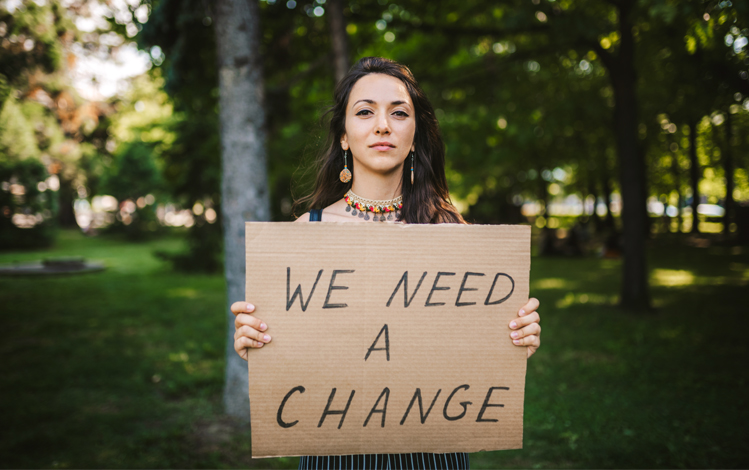

How Purpose-Led Brands Navigate Difficult Times
Brands are operating in a fractured society with unceasing stressors: rising prices, talent demands, extreme weather events, an ongoing global pandemic and civil unrest — to name just a few. Volatility is the rule rather than the exception.
During times of uncertainty, brands may be tempted to switch to “survival mode” — to abandon or downscale values-led initiatives on issues like climate change or social equity. The good news: There is rarely a need for binary decision-making, and organizations that shelve purpose-driven, long-term initiatives do so at their peril. Companies that stay the course will emerge stronger and may even command new market share, becoming a leader in their industry. As outlined in WE’s latest Brands in Motion report, “The Bravery Mandate: Make It Real,” the expectation for companies to speak and act on societal issues is here to stay.
Businesses have a responsibility to bridge the societal divide
WE’s 2022 Brands in Motion research finds that 80% of respondents agree that, during times of high social division, businesses and organizations have a moral obligation to help bridge differences. Yet, public sentiment is down: Only about half of brands are seen as delivering on their values-led commitments, and 68% of consumers surveyed believe that purpose and Environmental, Social and Governance (ESG) initiatives should not come at the expense of product affordability, access and performance.
Brands are facing an unprecedented degree of pressure from every corner, but the current stress test is good news for organizations willing to rise to the moment. Keep these three things in mind as you steer your brand through these challenging times:
1. Understand that purpose pays in the long run
Organizations that lead with purpose stand to gain in a variety of ways: Improving their bottom line, attracting and retaining talent, and building meaningful, authentic relationships with their customers.
However, communicating with customers about purpose can be tricky. WE’s Brands in Motion research finds that people expect brands to do the right thing, but they also want the quality and value of these products to remain constant.
Therefore, it’s important for brands to remember that purpose pays in the long run. According to a survey conducted by management-consulting company Deloitte, purpose-driven companies experience 30% higher levels of innovation and 40% higher levels of retention. And that’s not all: Forty-two percent of millennials said they have begun or deepened a business relationship because they perceive a company’s products or services to have a positive impact on society and/or the environment.
2. Focus on practicality
WE’s 2022 Brands in Motion research finds that respondents strongly prefer companies to focus their purpose-driven efforts on practical issues like cost of living and mental health. People want brands to invest in places where they have the most influence and power: their own organizations and employees. For example, Virgin Atlantic trains volunteer staff members to spot signs of distress in colleagues and provide them with assistance — a great example of an employee- and human-centric initiative that transformed crew members into mental-health advocates.
Nearly three out of five survey respondents expect brands to look out for their people and to prioritize employee well-being in the face of economic constraints. Companies must support their people during these challenging times by investing in their emotional wellness through mental and/or physical health programs.
3. Take people on your purpose journey — and stay the course
Consistency is key to maintaining brand loyalty and trust. Nearly 70% of survey respondents prefer that companies focus their efforts on a single cause, rather than support a different issue every year.
The most important thing to remember is to tell your story and make it matter. Your organization should tell stories closely aligned to your purpose. Consider a campaign by Procter & Gamble (P&G): “The Look” addresses issues such as diversity, equality and unconscious biases — topics that tie nicely with P&G’s overarching mission to be “a force for good and a force for growth.”
At the same time, brands should be more transparent when informing the public about their actions in response to current and emerging issues in society — even when those results fall short of expectations. Progress, not perfection, is what consumers are looking for. Gotham Greens, for instance, is upfront about its decision to use plastic packaging for its otherwise sustainable produce, calling it a difficult but necessary trade-off in the absence of viable alternatives. Sharing both setbacks and success stories will enable companies to build credibility with stakeholders.
The demands of these times may seem insurmountable, but pressure is what drives change: It’s what turns carbon into diamond. Now is the time for companies to act on their purpose: To make it happen, make it matter and make it real.
The latest blogs from WE
Decoding Gen Alpha: A Primer on the Next Gen of Consumers
Why Gen Alpha Will Fuel Spending This Season
Why Reputation Is a Business Driver in Healthcare


